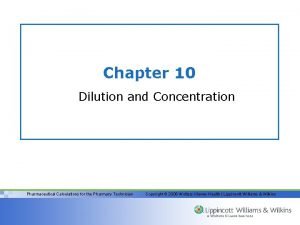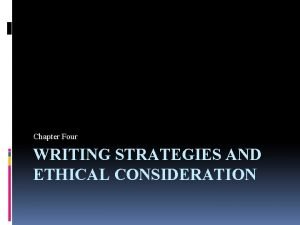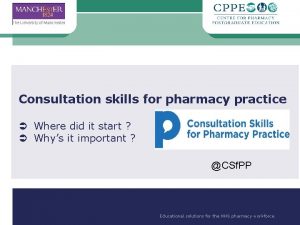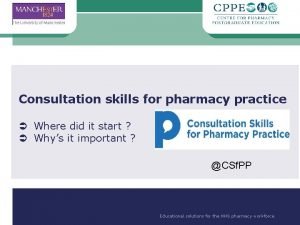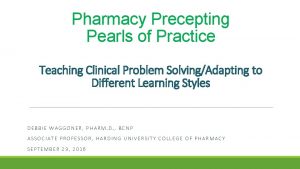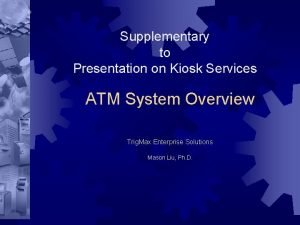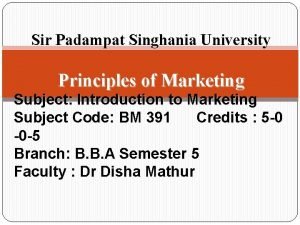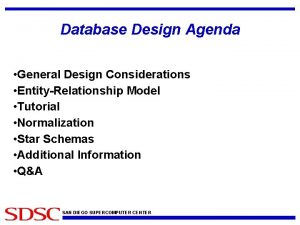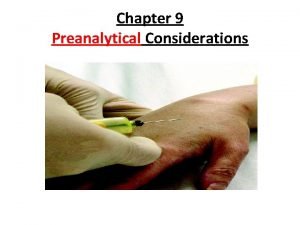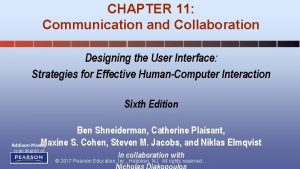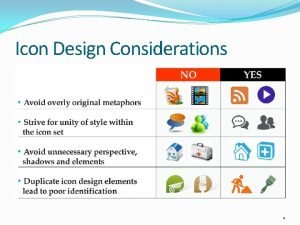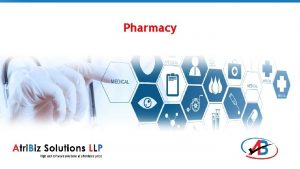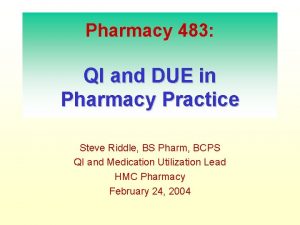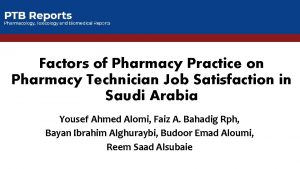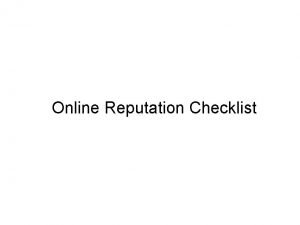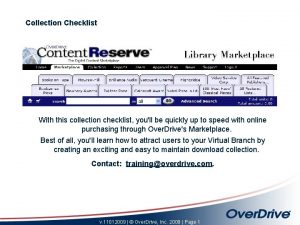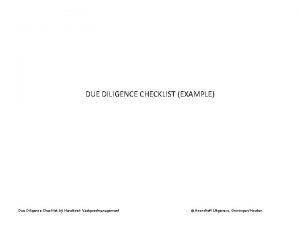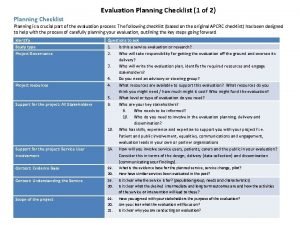Pharmacy practice considerations checklist Introduction and purpose Introduction

























- Slides: 25

Pharmacy practice considerations checklist

Introduction and purpose Introduction How to use this document The realized and potential impact of COVID-19 on pharmacy practice continues to evolve in 2020. To that end, we at Vizient have compiled pharmacy practice suggestions to consider as your organization navigates through this pandemic. These considerations were sourced from Vizient subject matter experts, our members’ experiences and the public domain. This document is intended to be a method that can be used to identity, prioritize and assign the considerations that your organization has decided to implement. We recommend that you evaluate each practice with the key stakeholders and determine which to implement, augment, customize, or disregard based upon your unique circumstances. Then, create your custom plan by deleting the considerations that your organization has disregarded and prioritizing the remaining efforts. The practice considerations are divided into four sections: administrative, operational, clinical and extended downtime/emergency operations, with relevant subsections for each when applicable 2 Vizient Presentation │ Date │ Confidential Information

Administrative pharmacy practice considerations 3 Vizient Presentation │ Date │ Confidential Information

Staffing and education Priority (high/medium/low) Practice consideration Evaluate current staffing model to support patient surges, including an assessment of current and future activities, roles and responsibilities with a primary focus on the medication use process. Give consideration to non-standard shifts, burnout avoidance techniques, decompression zones, adequate time off, infectious risk mitigation and staff input to organization-specific approach. Highlight support tools available to staff, and focus on strategies to decrease stress/burnout. Shift full-time employees (FTEs) as appropriate to cover changing needs (i. e. , from pre -op medication reconciliation to buyer support). Consider assigning a lead contact (e. g. , charge pharmacist, manager-in-charge) to each shift. Determine essential and non-essential duties of the department; redirect non-essential staff to essential duties (e. g. , leverage pharmacy students to support buyers, quality initiatives and other routine activities from which staff may be pulled). For organizations with unionized staffing, solicit agreement with union steward prior to making staffing changes. Identify a pharmacy information technology (IT) resource for rapid Electronic Health Record (EHR) changes. Consider altering IT workflow queue to prioritize COVID-19 changes. Plan for reallocating pharmacy staff to support changing inpatient population shifts from med/surg to critical care. 4 Vizient Presentation │ Date │ Confidential Information Owner Start date End date

Staffing and education Priority (high/medium/low) Practice consideration Consider telepharmacy when possible (e. g. , medication reconciliation, order verification, patient education, anticoagulation clinics, transitions of care activities, clinical consults). Evaluate and update policies and procedures surrounding work-from-home (WFH) processes if utilizing this model. Ensure changes in practice, staffing, or workflow are reviewed by a medication safety pharmacist or designated quality individual to avoid inadvertent consequences of action (e. g. introducing a medication alternative to replace a shortage drug without appropriate education, leading to a medication error). Leverage volunteer and support staff to transport medication and supply between facilities in multi-site organizations. For organizations with call center models, consider increasing staff and/or hours to account for call surges. For new and returning clinician workforce, ensure basic onboarding, orientation and education. Allocate activities appropriate to level of orientation and expertise. Leverage pharmacy students if available. Ensure all staff is current with institutional infection control guidelines and training modules including, but not limited to, proper personal protective equipment (PPE) use and instruction for donning, doffing and reuse. 5 Vizient Presentation │ Date │ Confidential Information Owner Start date End date

Communication Priority (high/medium/low) Practice consideration Create a workflow and cadence for real-time communication of pharmacy issues (e. g. , infrastructure needs, staffing challenges, medication/supply issues) with organizational leadership, pharmacy leadership and frontline clinicians. Monitor charge on administration and inventory management data to track and project utilization of critical medications. Communicate PAR levels and burn rate of COVID-19 -related and short medications with organizational leadership, pharmacy leaderships and frontline clinicians; include suggestions for alternative agents when able. Prepare an internal communication structure for real-time staff updates. Ensure staff access to pharmacy managerial tree (e. g. , on call, shift coverage). Consider reassigning historical managerial tasks to learners or other support staff. Monitor the HRSA website for dynamic guidance regarding 340 B, and communicate changes to appropriate pharmacy and compliance staff. Monitor the CMS MLN Matters website for CMS drug and procedure reimbursement changes. Access archived information here. 6 Vizient Presentation │ Date │ Confidential Information Owner Start date End date

Organizational and Human Resources Priority (high/medium/low) Practice consideration Collaborate with infection control department to evaluate risk and benefit of pharmacy movements and medication- stocking procedures. Partner with Human Resources and external vendors to plan for employee transportation to and from work. Revisit regional mutual aid agreements to address medication and supply sharing with consideration for the request sensitivity to overburdened organizations. Ensure a process for rapid transitions of staff in and out of automated dispensing cabinet (ADC) software, including all shifts. Consult Human Resources for list of voluntary healthcare workers provided by the State Healthcare Workforce Reserve for your organization. Collaborate with Human Resources regarding childcare needs for onsite and work from employees. Ensure pharmacy is included in the discussion and planning of organizational labor pools. Ensure rapid process for onboarding retirees or volunteer licensed professional staff as state specific regulatory bodies allow. Revisit organizational procedures in transitioning from medication nebulization to metered dose inhaler (MDI) use in infected or rule-out infection patients. Refer to the Vizient document: The Management of Inhaled Medications during the COVID-19 Pandemic. 7 Vizient Presentation │ Date │ Confidential Information Owner Start date End date

Advocacy Priority (high/medium/low) Practice consideration Advocate for state and federal policies to improve workforce numbers for pharmacists and pharmacy technicians as is currently being addressed with other professions as needed. Reach out directly to manufacturers for additional supplies or unpublished extended stability information on behalf of your facility when appropriate. 8 Vizient Presentation │ Date │ Confidential Information Owner Start date End date

Operational pharmacy practice considerations 9 Vizient Presentation │ Date │ Confidential Information

Personal protective equipment (PPE) Priority (high/medium/low) Practice consideration Ensure department staff are responsibly protected by the organizational standard PPE, including the settings of United States Pharmacopoeia (USP) <797> and <800>, with a focus on PPE conservation. Refer to the Vizient document: The Effect of PPE Supply Shortages on USP Compliance: Recommendations for Management. Amend existing PPE policy to provide guidance for extended use or limited reuse, as recommended by the CDC. Review departmental PPE policies, and consider adjustments to allow use of supplies not provided by the organization (e. g. , brought from home). 10 Vizient Presentation │ Date │ Confidential Information Owner Start date End date

Medication distribution Priority (high/medium/low) Practice consideration Review medication delivery and return workflow, with a focus to decrease risk of staff exposure to infectious particulates (e. g. , tubing restock to personnel already in isolation areas, minimizing traffic to areas, evaluate PAR levels in ADCs). Implement a process for managing reconciliation of temporary patients (e. g. , medication removal from ADC prior to patient registration). Inventory current medication and supply storage capabilities and consider repurposing from low utilization areas (e. g. , move refrigerated OR ADC to COVID-19 ICU). Redeploy medications and supplies from closed or underutilized units/areas to units with increased activity (e. g. , from the PACU to the ED). Evaluate crash cart medications (including PAR levels) in ADCs to potentially decrease cart utilization and reprocessing need. Consider removing carts from critical care areas if ADCs and supplies (e. g. , defibrillator, intubation kit) can adequately support patient code response. Assess crash cart number in areas of high patient codes; repurpose carts from closed units. Revisit bulk medication return process to ensure conservation of medication supply and product integrity. 11 Vizient Presentation │ Date │ Confidential Information Owner Start date End date

Medication distribution Priority (high/medium/low) Practice consideration Standardize ADC format in anticipation of new unit formation and/or expansion. Consider utilizing an ADC template to improve efficiency. If workflow permits, consider loading ADC in central pharmacy. Consider heightening controls on COVID-19 therapeutic medications (e. g. , count validation, secured bins, avoid open matrix pockets). Design operational and patient workflows to ensure optimal medication conservation (e. g. , bag size, use of proprietary vial-to-diluent systems, ready-touse (RTU), standard concentrations, on demand use, refrigeration of IV compounds, shift short-dated product to high-use areas). When permitted by state law, consider dispensing bulk medication products (e. g. MDIs, eye drops, infant vitamins) home with patients following inpatient stays with appropriate documentation and labeling to avoid waste and decrease retail pharmacy exposure. Review risks of brown- and white-bag intake to pharmacy, and implement mitigation strategies. 12 Vizient Presentation │ Date │ Confidential Information Owner Start End date

Medication administration Priority (high/medium/low) Practice consideration Evaluate medication safety vulnerabilities around bar-coded medication administrational workarounds in COVID-19 and rule-out patients. When clinically appropriate and safe, leverage alternative intravenous administration of medications (e. g. , bolus, push, gravity), as opposed to intermittent or continuous infusions, in order to conserve pumps for medications that require them for safety and/or accuracy. Consider risks of increased number of room visits in COVID-19/rule -out patients. Explore the implications of the trend towards increased extension tubing use as a mitigation strategy to avoid repeated room entry (e. g. , priming volume loss, drug waste, occlusion risk, risk of flushing vasoactive medications, manifold implications). 13 Vizient Presentation │ Date │ Confidential Information Owner Start date End date

Cleaning and distribution Priority (high/medium/low) Practice consideration Evaluate current process for the secure storage of used drug kit boxes with a focus on infection control risks in the setting of COVID-19 (e. g. , dirty storage in ADC, potential intermingling risk). Review and update current ADC decontamination protocols, and review training with staff. Create a plan to address the cleaning and decontamination of crash carts, medication returns, patient’s own medications, pneumatic tubes, kit boxes and any other possible returns to pharmacy with consideration for medication conservation. 14 Vizient Presentation │ Date │ Confidential Information Owner Start date End date

Purchasing and supply Priority (high/medium/low) Practice consideration Work with internal supply department and external wholesalers to plan for needs of medication support devices (e. g. , tubing extension, syringes, needles, connectors, empty bags, adaptors). For multi-site organizations, consider improved visibility between sites to allow knowledge of stock levels (e. g. , virtual inventory model, carousel visibility). Coordinate with wholesaler to aggregate product allocations to facilitate a central distribution model. Contact wholesaler to request increase in opioid cap which has been imposed due to Federal limitations. 15 Vizient Presentation │ Date │ Confidential Information Owner Start date End date

Retail Priority (high/medium/low) Practice consideration Encourage electronic prescribing when hardware, software and training allow. Reserve paper prescriptions for situations where no other options exist. Ensure staff awareness of legacy COVID-19 high-use medications to prevent potentially inappropriate prescribing (e. g. , hydroxychloroquine, azithromycin). Coordinate with insurers to explore expansion of chronic medications to 90 -day fills when applicable. Shift all possible retail transactions to delivery, mail or courier. Implement patient policies consistent with CDC guidance regarding face coverings. Follow CDC guidance recommending face masks for pharmacy staff. Utilize appropriate PPE for delivering medications to patient’s home. Limit patient numbers in retail pharmacy reception areas (e. g. , utilize texts when prescriptions are ready). Consider a barrier between the staff and patient counseling and sales areas (e. g. , table) to keep social distancing. Remove chairs in waiting area. Consider closing reception if realistic. 16 Vizient Presentation │ Date │ Confidential Information Owner Start date End date

Retail Priority (high/medium/low) Practice consideration Remove items which may encourage sharing/high touch opportunities including magazines, pens. Close self-service blood pressure units. Implement retail practices to minimize high-touch interactions with patients (e. g. , discourage cash transactions, do not accept bottle for refills). Install signage and floor markers alerting patients to follow six feet social distancing. Require gloves are worn for point-of-sale activity such as credit card transactions. Clean patient-facing register items between transactions. Evaluate current “meds to beds” program to assess potential COVID-19 -related vulnerabilities (e. g. , external vendor deliveries to patient care units, potential risk to delivery personnel, medication security). Coordinate public health testing for COVID-19 with state and local health department staff to determine persons meeting criteria for testing when applicable. Sites providing these services must utilize appropriate PPE (e. g. , respirator not cloth mask) as directed by OSHA respiratory protection standards. 17 Vizient Presentation │ Date │ Confidential Information Owner Start date End date

Unique considerations Priority (high/medium/low) Practice consideration Special populations exist for whom in-person treatments cannot be delayed or moved to a remote setting including, but not limited to: dialysis, plasmapheresis, wound care and infusion center patients. Strategic planning surrounding care of potentially compromised patients in these special populations should be undertaken (e. g. isolation, alternative scheduling models). Evaluate dialysis capabilities across various patient care settings, keeping in mind water supply (i. e. reverse osmosis) may be rate limiting. Continuous renal replacement therapy capacity may be challenging to scale. Assess needs, and coordinate supply of home/peritoneal dialysis with vendor. Health systems with a home health pharmacy program may consider leveraging courier services, tele-education, bulk deliveries and appropriate staff protections. Engage patient assistance with drug supply reimbursement, patient drug access or co-pay support. 18 Vizient Presentation │ Date │ Confidential Information Owner Start date End date

Clinical pharmacy practice considerations 19 Vizient Presentation │ Date │ Confidential Information

Clinical Priority (high/medium/low) Practice consideration Ensure WFH employees have appropriate resources to execute duties (e. g. , phone, computer, EHR access, software, VPN, video conferencing, policies and procedures, appropriate internet speeds, internal communication capabilities). Verify employee WFH-specific competencies (e. g. , ability to access electronic documents and platforms, complete hand off processes remotely, adherence to WFH guidelines). Plan for increased demand on clinical pharmacy staff and revisit current clinical pharmacy offerings. Anticipate an uptick in investigational drug service activity with increasing numbers of COVID-19 clinical trials (e. g. , staffing, storage, IT needs). Replace bedside patient care rounds with seated rounds (with appropriate social distancing) ± videoconference rounds when able and appropriate. Leverage technology to facilitate clinician-patient communication and follow up (i. Pad, point of care testing, web-based interactive tools, educational software). Anticipate increased demand for drug information requests from medical, nursing and other clinical staff. Assess ability to communicate with home caregivers in the setting of visitor restrictions. Evaluate novel solutions (e. g. , telepharmacy). 20 Vizient Presentation │ Date │ Confidential Information Owner Start date End date

Clinical Priority (high/medium/low) Practice consideration Evaluate the need for pharmacist in-room presence when supporting codes (i. e. , may consider supporting from outside room). Anticipate communication challenges during code situations due to participants’ PPE and mitigation plan (e. g. , read back, repeat). Review current analgesia, sedation and neuromuscular blocker protocols anticipating challenges with drug shortages, medication dependence and prolonged weaning requirements, risk: benefit of bolus vs continuous infusion. Collaborate with physicians and nurses to batch medication administration times or shift to extended/continuous infusion, limiting the number of daily room entries. Collaborate with physicians and nurses to batch laboratory draws limiting the number of daily room entries. Reassess the use of high-intensity monitoring protocols, such as insulin drips requiring hourly (q 1 hour) blood glucose monitoring, in order to determine the opportunity to limit repeated room entries. Anticipate medication requests for novel uses and delivery methods due to impending shortages (e. g. , fentanyl patches for ventilated patients, oral agents during sedative weaning, alternative pain/sedation agents such as ketamine) and have a plan to address these requests. 21 Vizient Presentation │ Date │ Confidential Information Owner Start End date

Extended downtime and emergency operations pharmacy practice considerations 22 Vizient Presentation │ Date │ Confidential Information

Extended downtime and emergency operations Priority (high/medium/low) Practice consideration Refer to NABP website for state-specific regulatory changes in pharmacy practice regulations. Anticipate addition of new patient care sites and the logistics (e. g. lack of electronic support, medication distribution and security, communication challenges, transcription issues) associated with provision of care in novel settings. Plan for alternative documentation needs and diversion challenges. Consider procurement and use of institutional prescription pads to address the needs of providers without access to electronic prescribing. Be mindful of potential delays in obtaining additional supplies if in a state requiring use of official prescription blanks. Coordinate with local retail pharmacies to address concerns related to paper prescriptions. Anticipate higher risk of cyber intrusion due to increase volume of remote work, phishing attacks and known increased international opportunistic activity. Consider review of current downtime procedures and the ability to support patient care for an extended period in the event of system interruption (e. g. , network, EHR, phone lines, product procurement channels). 23 Vizient Presentation │ Date │ Confidential Information Owner Start date End date

Vizient resources We at Vizient are committed to providing relevant and timely information to help you treat your patients and protect yourself during the COVID-19 pandemic. Below are a few of the resources available to you. For specific questions and assistance, please contact Disaster. Response@vizientinc. com. Available to the public: • COVID-19 FAQs Available to Vizient members: • Management of Inhaled Medications • Emerging Practices to Combat Coronavirus Disease (COVID-19) • Pharmacotherapy for COVID 19: Evidence Summary • Surge demand calculator • • Recordings of weekly webinars and more The Effect of COVID-19 PPE Supply Shortages on USP Compliance: Recommendations for Management For access to all available content, visit our COVID-19 Resources webpage. Disaster Preparedness webpage. 24 Vizient Presentation │ Date │ Confidential Information

This information is proprietary and highly confidential. Any unauthorized dissemination, distribution or copying is strictly prohibited. Any violation of this prohibition may be subject to penalties and recourse under the law. Copyright 2020 Vizient, Inc. All rights reserved.
 Alligation pharmacy
Alligation pharmacy Writing strategies and ethical considerations
Writing strategies and ethical considerations Experimental design and ethical considerations
Experimental design and ethical considerations Pricing considerations and approaches
Pricing considerations and approaches Consultation skills for pharmacy practice
Consultation skills for pharmacy practice Pharmacy practice
Pharmacy practice Consultation skills for pharmacy practice
Consultation skills for pharmacy practice Pharmacy clinical pearls
Pharmacy clinical pearls Gpp good pharmacy practice
Gpp good pharmacy practice General considerations in machine design
General considerations in machine design Tax considerations for setting up a new business
Tax considerations for setting up a new business Atm kiosk solution
Atm kiosk solution Exchange transaction and relationship in marketing
Exchange transaction and relationship in marketing Mechanical considerations of transmission line
Mechanical considerations of transmission line Database design considerations
Database design considerations Compare and contrast first and second language acquisition
Compare and contrast first and second language acquisition Cloud delivery model considerations
Cloud delivery model considerations Preanalytical considerations phlebotomy
Preanalytical considerations phlebotomy Bioreactor considerations for animal cell culture
Bioreactor considerations for animal cell culture Collaboration design considerations
Collaboration design considerations Mechanical principles of tooth preparation
Mechanical principles of tooth preparation Anatomical considerations
Anatomical considerations Biopharmaceutic considerations in drug product design
Biopharmaceutic considerations in drug product design Retromylohyoid curtain is formed by
Retromylohyoid curtain is formed by Dogso y spa
Dogso y spa Final design icon
Final design icon
